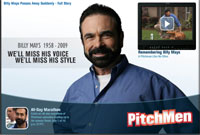 If you’re like most business owners, you’re interested in selling more stuff. Lately, you may have heard that Twitter is a great way to sell more stuff. However, if you’re not aware of the “why” behind marketing in general – it can be easy to begin viewing Twitter – and other social media tools – as a form of marketing magic.
If you’re like most business owners, you’re interested in selling more stuff. Lately, you may have heard that Twitter is a great way to sell more stuff. However, if you’re not aware of the “why” behind marketing in general – it can be easy to begin viewing Twitter – and other social media tools – as a form of marketing magic.
Without knowing the “why” you might be tempted to to view Twitter as “social media marketing magic” instead of viewing Twitter as a great way to deliver a short timely messages quickly and effectively to a group of people who’ve asked for this information.
An example of the “magical” fantasy style of thinking is a local business owner who wants to use Twitter to sell more of the stuff he sells – cars.
His logic is flawless. Dell computers uses Twitter very effectively to sell more stuff. This local business owners reads about Dell’s success and wants to harness the same “social media magic” so he can sell more “stuff” too. What could be easier?
Unfortunately, there’s a disconnect. Dell sells refurbished computers via a dedicated Twitter feed. Dell employees don’t “tweet” what they had for breakfast – they tweet the latest deals. Dell’s target audience is online – and they’re already using Twitter. So all Dell had to do was set up a Twitter account – and spread the word that if you wanted access to great bargains – follow them at Twitter and VIOLA – Dell is selling more computers using Twitter.
So the question at hand isn’t, “Can we make Twitter work to help us sell more stuff?” It can obviously do so. The real question is “HOW can we make Twitter work to sell more stuff?”
Which is the essential question we’re asking of ALL forms of media – whether it’s social media marketing or traditional media tools.
Of COURSE we CAN make Twitter “work” to sell more of just about anything – from cd’s to cars. However, it’s more than just a question of “how do I use Twitter?” Instead, it needs to be a question of “How do I COMMUNICATE with prospective customers/ clients?”
Let’s take the case of the car dealer who wants to use social media tools – Twitter in this case – to sell more cars.
The first step in crafting a social media marketing strategy with Twitter would begin by building a foundation of LOCAL Twitter followers – local residents who are actively car shopping and who want to be notified of special deals. With this in mind, you’d be surprised how often people FORGET that the WWW stands for WORLD wide web. Ten thousand Twitter followers in the UK won’t do a car dealership in Southern Florida much good. So the first “key” is to be sure to build a Twitter following of the “right” people.
The “right” Twitter followers
Just as in direct mail – the “magic is in the list” – in Twitter – the magic in using Twitter for marketing is in attracting the “right” followers. Once again – it’s better to have 100 Twitter followers who respond than 10K who are not responsive.
Who are the “right” followers? Well, to use “traditional “marketing terms – they’re also known as your “target” audience. For the car dealer – they’re local people who are – or who anticipate – being in the market for a new or used car.
Once you’ve defined your target audience – and created a Twitter profile which explains what followers can expect. (This is where a custom Twitter background come in handy.)
The uses of Twitter for a car dealership are truly exciting. A dealership could tweet about
- price reductions and sales
- rebates
- recent trade ins
- used cars scheduled to go to auction
The list of possibilities goes on and on – however you may notice that the “topics” here aren’t much different than the “topics” covered in traditional or “old school” media advertising.
When it comes to using Twitter to sell more stuff – the real “root” question is:
How are we already CONNECTING and COMMUNICATING with our prospective customers/clients?
The same message that “works” via other media will probably also “work” well with Twitter. As a matter of fact, once you’ve established that you’ve built a foundation of the “right” Twitter followers – you can begin using Twitter to “test” your marketing messages BEFORE you use them in “traditional” marketing or advertising campaigns.
THIS is why real marketing professionals get jazzed about Twitter. Instead of going to the time and expense of creating a split test mailing to test two possible headlines – Twitter allows a quick easy and EFFECTIVE way of testing those headlines instantly.
Twitter gets frustrating as a marketing tool when you don’t have a clear target audience and a clear marketing message to deliver to that target audience. Then again – that is when ALL marketing and advertising gets frustrating for businesses of ALL sizes. 🙂
 Long long ago,
Long long ago,  Here’s another real life story on “How Social Media” works. I hope it helps to illustrate WHY it’s so hard to put an ROI value on your social media participation.
Here’s another real life story on “How Social Media” works. I hope it helps to illustrate WHY it’s so hard to put an ROI value on your social media participation. In the post –
In the post – There’s a lot to be learned from social media – but Danny Dover makes a case for
There’s a lot to be learned from social media – but Danny Dover makes a case for  There’s all kind of cachet around “being first”. In Immutable Laws of Internet Branding – we are told that you absolutely MUST be “first” if you want to win in business and branding. But is it true? Is there really that much economic value in being “first”?
There’s all kind of cachet around “being first”. In Immutable Laws of Internet Branding – we are told that you absolutely MUST be “first” if you want to win in business and branding. But is it true? Is there really that much economic value in being “first”? A former client of mine is anxious to get her business off the ground and has bought into the “hype” surrounding social media. She doesn’t understand it – but she’s pretty sure that social media is the key to getting her business off the ground.
A former client of mine is anxious to get her business off the ground and has bought into the “hype” surrounding social media. She doesn’t understand it – but she’s pretty sure that social media is the key to getting her business off the ground. The straightest path between two points is a line – but when it comes to connecting with your customers – the path is anything but linear.
The straightest path between two points is a line – but when it comes to connecting with your customers – the path is anything but linear.
 WIIFM – What’s In It For Me – it’s the foundation for any successful marketing campaign. However, it’s important to note that the What’s In It For Me should not in any way, shape or form be applied to your OWN selfish needs and desires. You must maintain laser focus instead upon the satisfaction and delight of your customers and potential customers.
WIIFM – What’s In It For Me – it’s the foundation for any successful marketing campaign. However, it’s important to note that the What’s In It For Me should not in any way, shape or form be applied to your OWN selfish needs and desires. You must maintain laser focus instead upon the satisfaction and delight of your customers and potential customers. Piss poor customer service will kill your business almost as quickly as piss poor marketing will!!!
Piss poor customer service will kill your business almost as quickly as piss poor marketing will!!!



